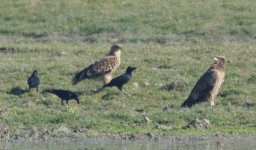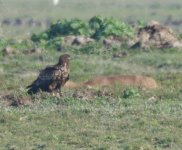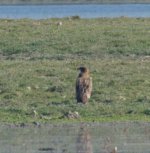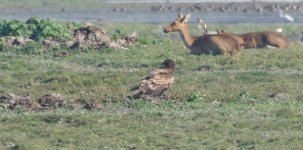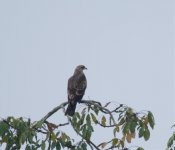-
Welcome to BirdForum, the internet's largest birding community with thousands of members from all over the world. The forums are dedicated to wild birds, birding, binoculars and equipment and all that goes with it.
Please register for an account to take part in the discussions in the forum, post your pictures in the gallery and more.
You are using an out of date browser. It may not display this or other websites correctly.
You should upgrade or use an alternative browser.
You should upgrade or use an alternative browser.
Guys ID help needed, thanks (1 Viewer)
- Thread starter wwwbaldeagle
- Start date
More options
Who Replied?Guêpier8888
New member
Good evening,
I think that on the first photo, they are Bonelli's Eagles. I can not say, for the other photos, which species it is.
Cordially
Mathis
I think that on the first photo, they are Bonelli's Eagles. I can not say, for the other photos, which species it is.
Cordially
Mathis
RafaelMatias
Unknown member

1: they look like Eastern Imperial Eagles to me
2-5: White-tailed Eagle
6: Crested Honey Buzzard
2-5: White-tailed Eagle
6: Crested Honey Buzzard
PYRTLE
Old Berkshire Boy

1: they look like Eastern Imperial Eagles to me
2-5: White-tailed Eagle
6: Crested Honey Buzzard
What pictures are you looking at Rafael? I haven't got a no.6 on my monitor.
RafaelMatias
Unknown member

What pictures are you looking at Rafael? I haven't got a no.6 on my monitor.
Oooops, thanks!
It's photos:
1
2-4
5
Hope this helps.
wwwbaldeagle
Active member
Oooops, thanks!
It's photos:
1
2-4
5
Hope this helps.
Are you sure 3 is an imperial though?
RafaelMatias
Unknown member

Are you sure 3 is an imperial though?
I went through image 3 too fast and assumed it to be the same as the adjacent images (White-tailed Eagles). It looks like it's not, sorry, and I'm not sure what it is. It would also be interesting to hear further opinions about the birds on pic 1.
sicklebill
well-known Cretaceous relic

Hmm, well in some haste admittedly, but I would have Indian or Greater Spotted eagle in contention, I suspect White-tailed eagle is rare in India but Pallas's Fish Eagle might be a contender, and the last bird looks like a Black Kite, the bill is foreshortened but the plain tail with a fork and the dark eye-line fit well, perhaps one of the lineatus group.
RafaelMatias
Unknown member

Re 5: the tail is being split by a branch; nostril is visible (diagonal slit like, indicative of Pernis); the adult-type gorget is just beginning to show.
RafaelMatias
Unknown member

I'll blame this on the fact that I've got the flu and I'm a bit feverish at the moment (of course... :smoke:...)
I have no experience whatsoever with Pallas's Fish Eagle (I guess this fact might be more to blame! ), but by looking again at image 1, trying not to neglect features I was actually seeing but not valuing, I can see now the apparently bare tarsi on the far right raptor (which rules out Aquila eagles, if a real feature). In fact, after browsing through a few photos, it fits quite well with an immature Pallas's FE, perhaps not dissimilar to this one: http://www.orientalbirdimages.org/b...pecies&Bird_ID=864&Bird_Family_ID=&pagesize=1 (which is labeled wrongly as an adult), even the dark facial patch. The bird further back has its tarsi hidden by the crow, but I sense a different species (with a more horizontal posture) and the longitudinal striations on the underparts still make me think of EIE as a contender.
), but by looking again at image 1, trying not to neglect features I was actually seeing but not valuing, I can see now the apparently bare tarsi on the far right raptor (which rules out Aquila eagles, if a real feature). In fact, after browsing through a few photos, it fits quite well with an immature Pallas's FE, perhaps not dissimilar to this one: http://www.orientalbirdimages.org/b...pecies&Bird_ID=864&Bird_Family_ID=&pagesize=1 (which is labeled wrongly as an adult), even the dark facial patch. The bird further back has its tarsi hidden by the crow, but I sense a different species (with a more horizontal posture) and the longitudinal striations on the underparts still make me think of EIE as a contender.
I'm positive about the Honey Buzzard (Crested/Oriental) ID, and on photos 2 and 4 I still can't see a Pallas'sFE there (pattern of coverts, shape of head with no "mane") but I'm happy to be shown otherwise. It's proving to be educative (for me at least!) and not as straightforwards as it looked like in the beginning... :eat:B
I have no experience whatsoever with Pallas's Fish Eagle (I guess this fact might be more to blame!
I'm positive about the Honey Buzzard (Crested/Oriental) ID, and on photos 2 and 4 I still can't see a Pallas'sFE there (pattern of coverts, shape of head with no "mane") but I'm happy to be shown otherwise. It's proving to be educative (for me at least!) and not as straightforwards as it looked like in the beginning... :eat:B
wwwbaldeagle
Active member
Thanks! Any idea about 3 though?I'll blame this on the fact that I've got the flu and I'm a bit feverish at the moment (of course... :smoke:...)
I have no experience whatsoever with Pallas's Fish Eagle (I guess this fact might be more to blame!), but by looking again at image 1, trying not to neglect features I was actually seeing but not valuing, I can see now the apparently bare tarsi on the far right raptor (which rules out Aquila eagles, if a real feature). In fact, after browsing through a few photos, it fits quite well with an immature Pallas's FE, perhaps not dissimilar to this one: http://www.orientalbirdimages.org/b...pecies&Bird_ID=864&Bird_Family_ID=&pagesize=1 (which is labeled wrongly as an adult), even the dark facial patch. The bird further back has its tarsi hidden by the crow, but I sense a different species (with a more horizontal posture) and the longitudinal striations on the underparts still make me think of EIE as a contender.
I'm positive about the Honey Buzzard (Crested/Oriental) ID, and on photos 2 and 4 I still can't see a Pallas'sFE there (pattern of coverts, shape of head with no "mane") but I'm happy to be shown otherwise. It's proving to be educative (for me at least!) and not as straightforwards as it looked like in the beginning... :eat:B
Thanks! Any idea about 3 though?
Why isn't that immature Pallas's fish eagle?
http://www.orientalbirdimages.org/birdimages.php?p=19&action=birdspecies&Bird_ID=864&Bird_Family_ID=&pagesize=1
RafaelMatias
Unknown member

Why isn't that immature Pallas's fish eagle?
http://www.orientalbirdimages.org/birdimages.php?p=19&action=birdspecies&Bird_ID=864&Bird_Family_ID=&pagesize=1
The bird on pic 3 is actually on the same spot on the ground as the right hand bird of pic 1, from comparing several features of the foreground (water margin, several unique shaped dirt "mounds"/blobs), just from a slightly different angle. Thus your suggestion makes total sense to me, as it should be the same bird on both photos (presumably).
Last edited:
wwwbaldeagle
Active member
The bird on pic 3 is actually on the same spot on the ground as the right hand bird of pic 1, from comparing several features of the foreground (water margin, several unique shaped dirt "mounds"/blobs), just from a slightly different angle. Thus your suggestion makes total sense to me, as it should be the same bird on both photos (presumably).
However doesn't 3 seem to have a darker back
RafaelMatias
Unknown member

Note that the darker patches on 3 are on the scapulars only, which are basically not visible on bird 1 (only the wing is fully visible, in full side view); a pale patch on the greater coverts is consistently present on the bird on both photos.

1: Eastern Imperal and Pallas Fish
2: White-tailed
3: Pallas Fish
4: White-tailed
5: Oriental HB
Pallas Fish Eagle has smaller bill and head than White-tailed, whereas White-tailed Eagle has typical juvenile pattern of upperparts, both have bare tarsi which makes them Fish Eagles
2: White-tailed
3: Pallas Fish
4: White-tailed
5: Oriental HB
Pallas Fish Eagle has smaller bill and head than White-tailed, whereas White-tailed Eagle has typical juvenile pattern of upperparts, both have bare tarsi which makes them Fish Eagles
Similar threads
Users who are viewing this thread
Total: 2 (members: 0, guests: 2)




